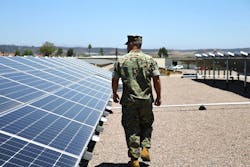Assistant Army Secretary: Military Advancing in its Work Deploying Microgrids at Bases
Last year, the U.S. Army released its climate strategy that called for a microgrid at every installation by 2035. This was a huge promise, but only part of the equation in the report.
So far, it's one of the military's climate promises showing the most achievement.
Microgrid Knowledge is covering several movements along this energy front, including the work at the Joint Forces Training Base in Los Alamitos, California. The successes and challenges of the project were highlighted at the Microgrid 2023 Conference by panelists from the U.S. Army and developer Bright Canyon Energy, which recently sold the microgrid to Ameresco.
The Los Alamitos project is already operational in many of its parts which includes solar, battery storage and tier 4 diesel gen-sets as backup power. The California National Guard recently celebrated the work with a ribbon-cutting ceremony at the base in August.
There’s much more where that came from, as the military bolsters it’s energy resiliency with microgrids and other distributed energy installations. In fact, Rachel Jacobson, assistant secretary of the Army for installations, energy and the environment, told military news site Defense Now that the Army microgrid initiative has been “enormously successful” thus far.
Nearly 30 microgrids are operational at installations. Another nine are under construction and 26 in the design phase, according to Jacobson and Defense Now.
Last year, Marine Corps. Base Camp Lejeune in North Carolina contracted utility Duke Energy to build a $22 million microgrid there. The Marines also had a microgrid installed at Base Miramar near San Diego.
The other services have microgrids including work the Navy did with the National Energy Renewable Laboratory on the Hawaiian island of Kauai. Last year, the U.S. Department of Defense enlisted Xendee to help it strengthen its microgrid certification efforts.








